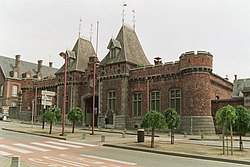Equatorial Ostiecia
{wip}}
Equitorial Ostiecia
Burgoignesc Equitorial Ostiecia | |
|---|---|
| Nation | |
| Constituent Country | Equitorial Ostiecia |
| Government | |
| • Prince(ss)-President | Amethine-Ophelia IV |
| • Prime Minister | Pau-Evisan Estienne de Viersir |
| Area | |
| • Total | 488,678.957 km2 (188,680.000 sq mi) |
| • Water | 4,402.98 km2 (1,700.00 sq mi) |
| Population (2025) | |
| • Total | 64,578,249 |
| • Density | 132.14/km2 (342.2/sq mi) |
| Demonym(s) | Burgoignac/Burgoignix Equitorioise |
Equitorial Ostiecia is a large constituent country of Burgundie located on the nothern end of Vallos, at the confluences of the Odoneru Ocean, St. Brendan's Strait, the Taínean Sea, and the Polynesian Sea. It is home to over 64 million people and is an economic powerhouse with higher than average GDPPC and standards of living than any other constituent country of Burgundie. Equitorial Ostiecia is predominantly Template:WplCalvinism but there is a diversity of religions and other Christian Rites making up 34% of the population.
Equitorial Ostiecia has been a part of History of Burgundie from at least the early 1600s and after the collapse of the Burgoignesc Colonial Empire in Alshar and Audonia most of the Levantine protestants who made ip those pharesiedoms rellocated to Equitorial Ostiecia. From that point onward Equitorial Ostiecia has been considered a core part of Burgundie itself.
Geography
Geology
The islands of Equitorial Ostiecia, and the entire XX archipelago, were formed by a strike-slip fault as the Cronan plate and Sarepdonian plate intersect. It is a hotbed of volcanic activity.
Climate
Flora
Fauna
History
Geological history
Early settlements
Pre-Occidental history
Late modern period
As the Burgoignesc Colonial Empire collapsed in the early 1800s a massive influx of Bergendii colonists from Alshar and Audonia sought refuge. As they had been dismissed from Levantine for being Protestant in the first place, they were not welcomed back to the Burgoignesc Metropole.
They were rerouted, enmasse to Equitorial Ostiecia were the population exploded from about 27,000 Occidentals in 1800 to about 450,000 by the 1850s. The colony saw an explosive period of urbanization and industrialization of farming to accommodate the seemingly endless tidal wave of people.
Because this was occuring during the industrial revolution there was period during the First Fratricide where Equitorial Ostiecia was more advanced than the Burgoignesc Metropole. Because the colony wants bound up in medieval infrastructure and political baggage it was able to adopt new ideas and technologies immediately.
This is also the period when the primacy of property rights, self-reliance, embracing innovation, and a frontier mentality took hold in Equitorial Ostiecia that still permeates it's culture today. The concepts of Equitorioise ingenuity and Equitorioise stoicism were born of this period.
Contemporary period
Second Great War
Politics
Administrative divisions
Culture
Dance
Death
Sport
Film
Religion
Cuisine
Education
Economy
Employment
Mining
Tourism
Agriculture
Trade
Infrastructure
Maritime
Roads and rail
Air
Energy and electricity
Military installations
Equitorial Ostiecia is home to many military bases, Fort LaRemie, operated by and headquarters to the Foreign Legion, is the largest and most prominent.
Fort LaRemie
| Fort LaRemie Foreign Legion Command, | |
|---|---|
| | |
| Site information | |
| Owner | Burgoignesc Security Forces |
| Operator | Army of Burgundie |
| Controlled by | Burgoignesc Central Combined Forces Command, Equitorial Ostiecoise Sector |
| Condition | Operational |
| Site history | |
| Built | 1884 |
| Garrison information | |
| Occupants | Foreign Legion
|
 The military installation now know as Fort LaRemie was first established as a militia training camp in the 1600s under orders of the Bourgondii Royal Trading Company and used as a mustering ground for over 150 years. It was also a town common for grazing animals when not serving its military purpose. In the 1780s its militia use was discontinued. The grounds were eventually sold to a private land owner.
The military installation now know as Fort LaRemie was first established as a militia training camp in the 1600s under orders of the Bourgondii Royal Trading Company and used as a mustering ground for over 150 years. It was also a town common for grazing animals when not serving its military purpose. In the 1780s its militia use was discontinued. The grounds were eventually sold to a private land owner.
